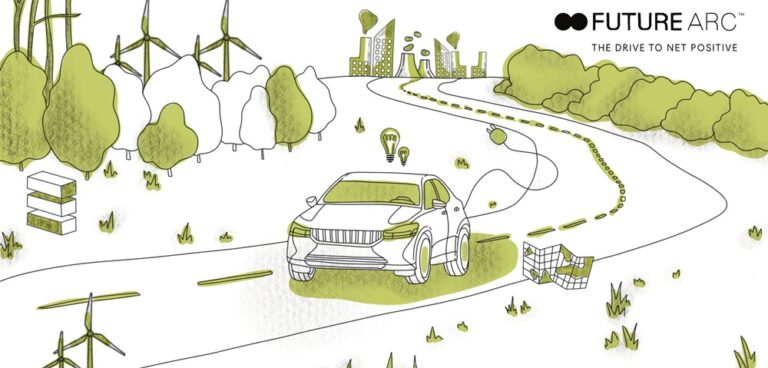Like many SME’s, at Future Arc we have had our impact on the planet close to mind over the last few years. Future Arc is an innovation and venturing studio. We work with large organisations to deliver complex digital transformation projects and whilst our work is big, our team is small yet mighty.
Recently, we have been pushed into action thanks to the need to qualify for a UK Government Framework. Part of our bid process required us to submit a Carbon Reduction Plan, and this has now kicked our business into a much needed drive to Net Positive.
Wyndham Plumptre, summarises his company’s journey to Net Positive and what they went through, with an aim to support other organisations who may be keen to act but are feeling insufficiently tooled to do so. It’s designed to help Small & Medium Organisations who may not have the same resources as Large Organisations to get behind the E in ESG.
So how do you develop one, what should it include and what is the best practice? In the rest of this article, I take you through our process to set out our Carbon Reduction Plan.
Net Zero or Net Positive
Firstly, Net Zero vs Net Positive. We originally started out developing our plan to drive towards Net Zero, and this felt insufficient. We have now set out a plan to drive to Net Positive.
The key difference between the two is:
- Net Zero: A target of completely negating the amount of greenhouse gases produced by human activity, to be achieved by reducing emissions and implementing methods of absorbing carbon dioxide from the atmosphere.
- Net Positive: A new way of doing business which puts back more into society, the environment and the global economy than it takes out.
Looking through both lenses in the process it was evident they drove very different mindsets. For Net Zero we were looking at how we could change as an organisation in what we do day-to-day to bring our carbon footprint to zero. For Net Positive it ended up making us review, consider, and adapt who we are as an organisation to enable us to be Net Positive.
We are still working through the implications of this, but I feel the learning is important for others. Some of the actions that are essential to protect our planet’s future include changing the core purpose, mission and driving force for your organisation.
For many, that will be a significant shift that could put at risk the future of their organisation. A key musing is whether the risk of not acting in this way and being willing to shift the whole fibre of an organisation, is greater.
Developing our Carbon Reduction Plan
Step 1 – Structuring:
For our first step, we set out the different content that we thought our plan should require.
This covered sections on:
- Our Carbon mission
- Our Approach to Net Positive
- Carbon Reduction Key Principles
- Enablers to deliver our Principles
- How we’d Baseline our Carbon Footprint
- Setting out our Baseline
- Developing our Reduction Plan against the 3 scopes
- Developing wider corporate actions to support the delivery of our plan
Step 2 – Creating an Environment for Change:
Once we had our plan we set some key structures that help to create the environment for success. This included:
- Setting out or Carbon Mission – essential to have a north star for Net Positive that the organisation can rally around.
- Outlining our Approach to Net Positive – this was missing at the start, and we had to develop our plan into something cohesive. Image 1 sets out our approach below.
- Developing Key Principles – Setting out the key principles for how we would deliver Net Positive as an organisation. Image 2 sets out our principles below.
- Defining Enablers – Outlining any enablers that we need to complete to help us deliver to the key principles we set out. Image 3 sets out our enablers aligned to the principles is below.
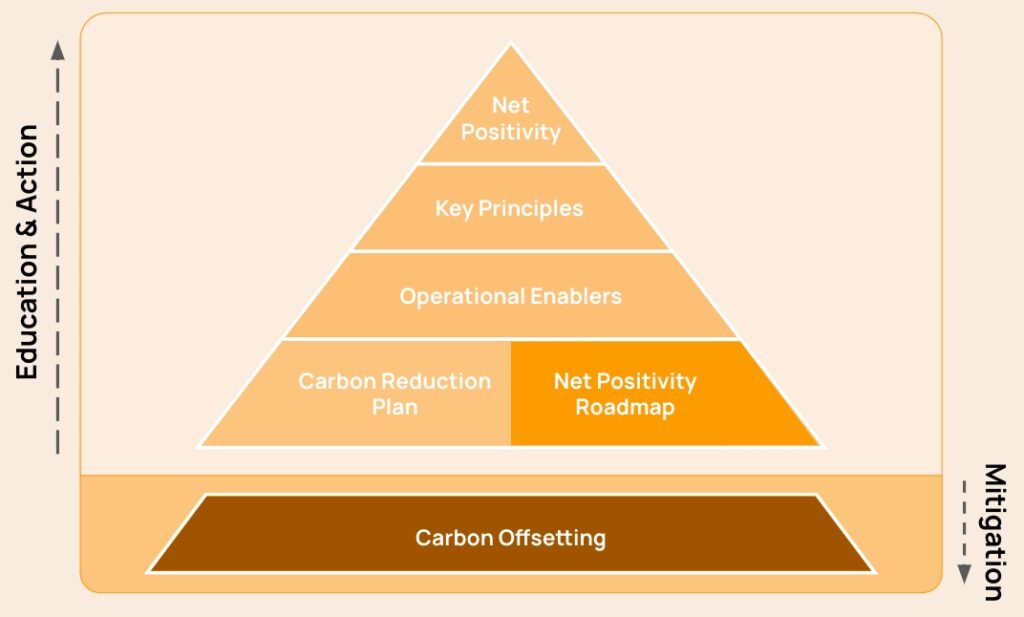
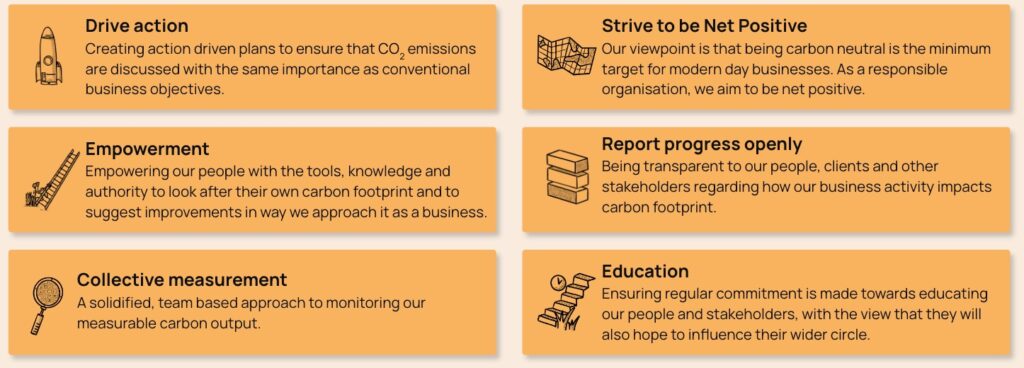
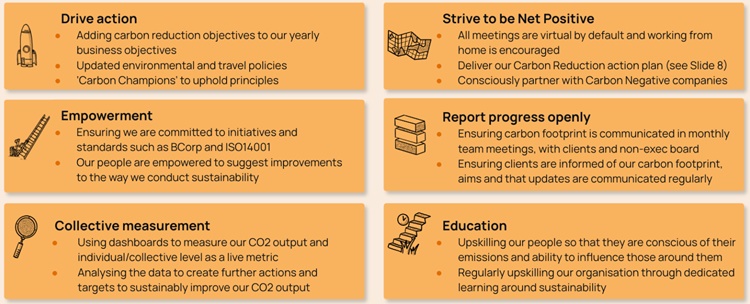
Step 3 – Baselining:
Key to undertaking any measurement of impact is defining a clear baseline of things to be measured and the current performance against which progress can be reported.
To do this we set out where we thought our organisation impacted the environment against the three different types of business-related Greenhouse Gas (GHG) emissions.
- Scope 1: This covers GHG emissions directly made by a company e.g. company cars
- Scope 2: The emissions made indirectly e.g. Office energy
- Scope 3: The emissions associated with the businesses supply chain e.g. energy used developing parts in the production of goods sold by the business
Against each of the scopes we then set our specific business activities that applied to our business and the specific measures we would aim to understand. These covered:
- Scope 1:
- Business travel to our core place of work (our offices).
- Business travel to our customers’ sites to support project delivery.
- Office energy usage.
- Scope 2:
- Energy usage from other business activity e.g. Data Hosting
- Scope 3:
- Supply Chain carbon footprint
Each of our Business Activities gave us something to measure our existing impact against.
For example – Scope 1, Business Travel to our Core Place of Work gave us three measurements to baseline, train, plane and car.
This gave us the structure against which to measure.
Step 4 – Measuring Status Quo:
To note, we set our baseline against what our full annual emissions could be for 2021 assuming staff and operating level at the end of the year.
Once we had a baseline, we could then quantify the number of impact events, the size of the impact events and how we measure them based on (wherever possible) industry data.
Taking the example above, we calculated that our team undertook:
- Scope 1, Train to work – 684 journeys at an average of 499 miles creating c.4tCO2e in emissions
- Scope 1, Plane to work – 1 journey of 379 miles creating c.0.3tCO2e in emissions
- Scope 1, Car to work – 0 journeys of 0 miles creating 0tCO2e in emissions
The below image sets out our baseline measurement for 2021. There are some references in the image that we have included at the bottom of this article. In total, across all our impact actions we c.13.84tCO2e in emissions in 2021.
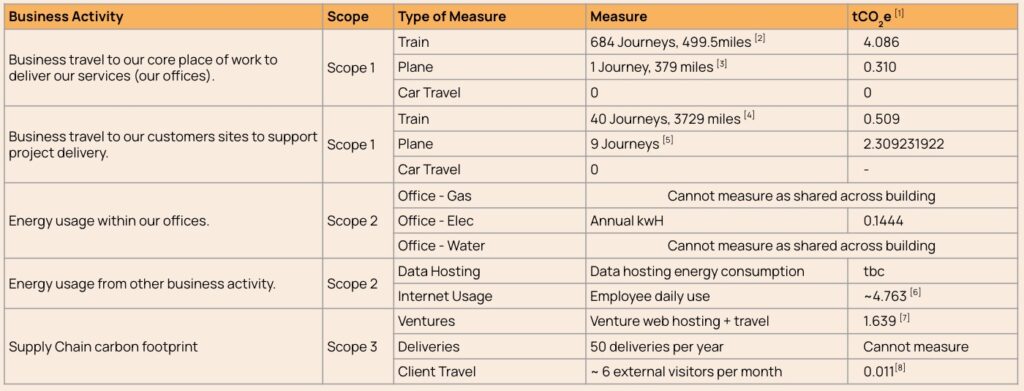
There were some impacts we could not baseline e.g. Gas & Water usage as it is shared across our office block.
Interestingly, our greatest emitter was in fact our use of internet services (as you can see from the table above).
Step 5 – Setting out Action and Measure:
Once we had a clear set of Business Activities, and a baseline of impact, we could then workshop what different actions could be to help reduce our impact. We assessed these against different criteria:
- Helping to improve: Actions to be taken to reduce our GHG emissions e.g. reduce travel to customers
- Enabling Net Zero: Actions to be taken that enable Net Zero e.g. require that employees only travel to customers for essential meetings and embed that as a contractual obligation in customer contracts
- Enabling Net Positive: Actions to be taken to enable Net Positive e.g. adapt our service offering so that we help our customers remove any associated travel related to a service we provide them
We then defined an overall corporate target for the year ahead, in this instance reducing our overall impact by 25%. The actions then taken were specific to hitting that target.
Key Learnings & Insights
To finish this section, we wanted to summarise some of the key learnings from the process we went through:
- There is no set standard for this, especially for SMEs.
- This requires work to understand, plan and act.
- The activity makes you question the organisations’ role in a Net Positive future.
- Reduction plans will be different for different types of business e.g. Product vs Service, Technology vs People.
- There are conflicting sources of measurement data.
- It will be extremely difficult to retrospectively get to 100% accuracy. 80% there for 20% of the effort is a great place to start.
- Embedding corporate governance is critical to acting on the insight and holding the organisation to account.
What Next (managing Actions & Progress)
Once we had our clear baseline developed the focus then turned to developing a clear action plan to hitting the targets we set.
We split our action plan into two covering:
- Specific actions against each Scope of emission
- General actions to be taken to enable Net Positive
Images of both of these are outlined below.
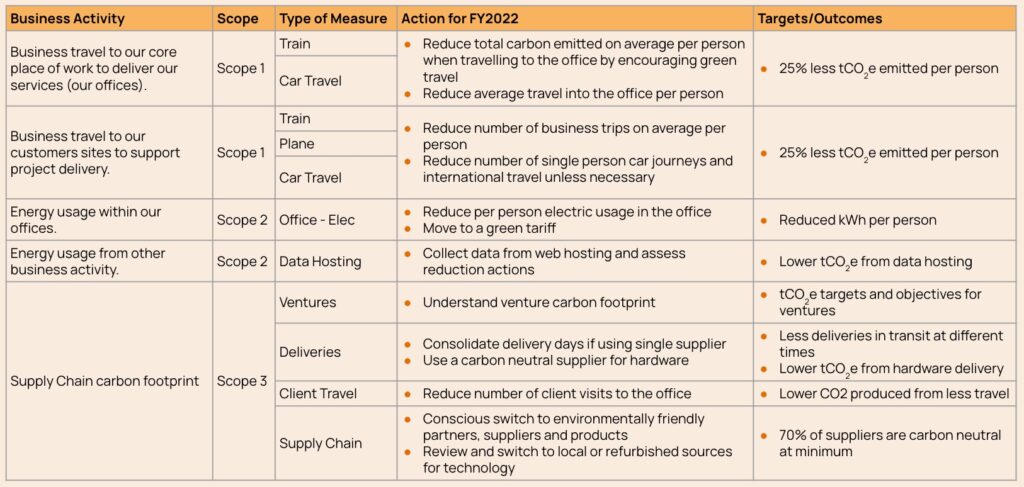

Step 6 – Implementing & Reporting:
Now that we have a baseline and an action plan, it is about implementation and reporting against the delivery of that plan. For implementing, we are now taking specific actions across the company to deliver.
Examples of these cover:
- Maintaining a flexible work from home policy;
- Reducing travel to client sites where possible and agreeing contractual carbon reduction with clients; and
- Re-tendering key components of our supply chain to put in place suppliers that support a reduction in our Scope 3 emissions.
From here, we then focus on reporting progress against our carbon footprint. This is done through our Environmental Management Committee which meets quarterly. This is something we put in place to maintain our ISO standards. This group is provided with a report on the quarterly emissions and updates against critical actions from both the Carbon Reduction Plan and Net Positive Roadmap.
The output from this is then cascaded up to the Non-Executive Board which also meets quarterly as a sub-committee update.
In Conclusion
The process that we have gone through to put this in place is extensive and requires effort, but we’re determined that our experience can provide a blueprint to help others.
The key takeaways from the process, and how it is helping us to action our drive to Net Positive, are:
- Understanding of the Business Activities that contribute GHG
- How to set out our baseline that we have as an organisation
- Developing key actions e.g. setting out new operational policies, ways of working to drive to Net Positive
- Defining the corporate oversight for delivery of our Carbon Reduction Plan and how progress will be reported (to our Non-Exec Board)
The key steps are all about action, and in this piece we’ve provided you with a simple guide to following in our footsteps.
It’s daunting but it doesn’t have to be difficult.
Key References
- [1] tCO2e is calculated using DEFRA formulae
- [2] Based on each individual employees commute to work against an approximation into many times they visit the office per month * 12
- [3] Based on one employee living in Ireland, commuting to London
- [4] Based on an average month of client site travel * 12
- [5] Based on number of flights taken per year
- [6] Based on statistics from this source, followed by this formula to calculate yearly use (414kg/365 * 200 = 226.8kg per person annually)
- [7] Report from AWS shows 0 emissions from data hosting. Figure is due to international travel.
- [8] Approximation of 6 external visitors per month * average commute distance in London

